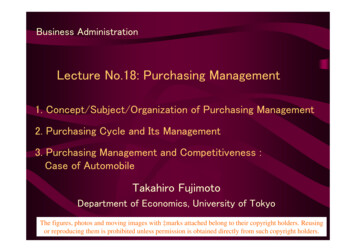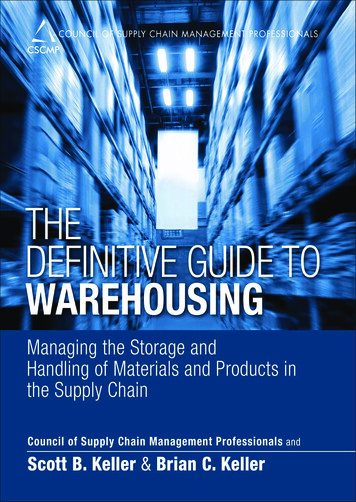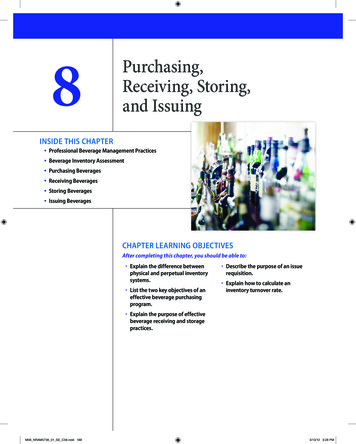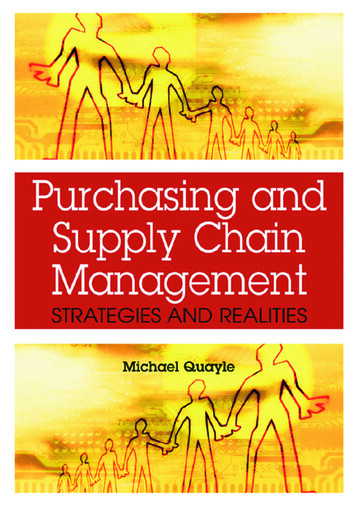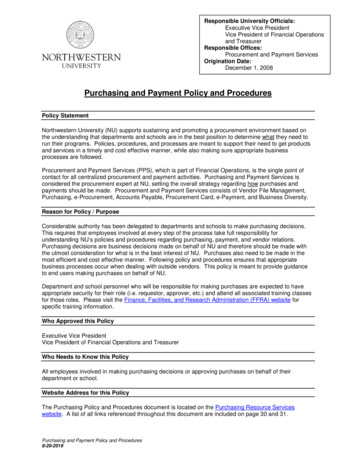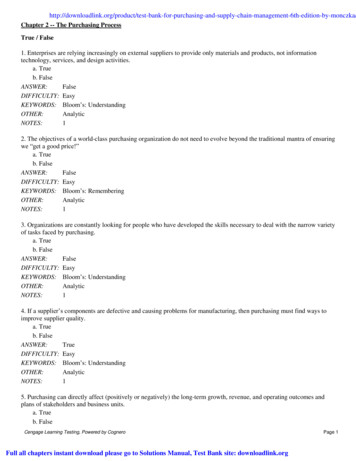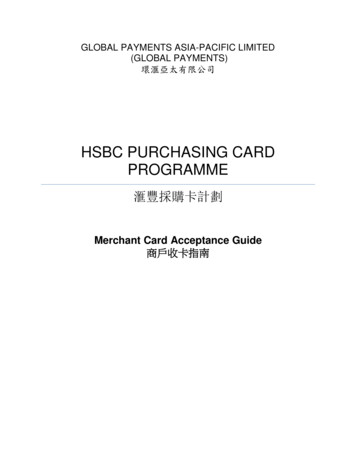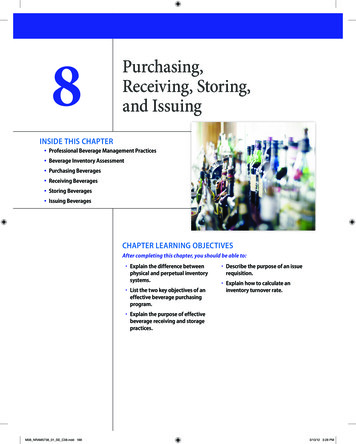
Transcription
8Purchasing,Receiving, Storing,and IssuingInside This Chapter Professional Beverage Management Practices Beverage Inventory Assessment Purchasing Beverages Receiving Beverages Storing Beverages Issuing BeveragesChapter Learning ObjectivesAfter completing this chapter, you should be able to: Explain the difference betweenphysical and perpetual inventorysystems. L ist the two key objectives of aneffective beverage purchasingprogram. D escribe the purpose of an issuerequisition. Explain how to calculate aninventory turnover rate. Explain the purpose of effectivebeverage receiving and storagepractices.M08 NRAM5738 01 SE C08.indd 1883/13/12 3:28 PM
Key Termsaverage inventory,p. 207first in, first out (FIFO),p. 193license state, p. 194capital, p. 197inventory turnover rate,p. 207perpetual inventory,p. 192last in, first out (LIFO),p. 193physical inventory, p. 191cash flow, p. 197control state, p. 194cost of goods sold (COGS),p. 207lead time, p. 198order point, p. 198rotation, p. 201safety level, p. 198Case Study“How can you run out of my favorite gin?”, demanded the customer.Marco, the bartender at the Votive Restaurant, tried to explain. “We reallydon’t sell much of that brand. It looks like we forgot to restock it and we ranout. I can get you another brand.”Marco knew this guest, who was usually friendly and tipped well. But nottoday.“Young man,” grumbled the customer, getting up to leave, “if I wanted badgin, I would have gone somewhere else. I came here because you usually havethe best bar selection in town.”“This happens way too often,” thought Marco. “Last week we ran out of apremium vodka. And the week before that, we ran out of our most populardraft beer.”Both times some customers got mad, and it showed up in lower tips. Marcowondered why the manager couldn’t keep the right products in the rightamounts on hand at the right time.1. How do you think the lack of popular beverages affects the customersand the employees of an establishment?2. What will happen in an establishment if it continually runs out of thebeverage brands or products its customers prefer?189M08 NRAM5738 01 SE C08.indd 1893/13/12 3:28 PM
CHAPTER 8Purchasing, Receiving, Storing, and IssuingPROFESSIONAL BEVERAGE MANAGEMENT PRACTICESManagers face a variety of challenges in securing and maintaining theproducts needed to serve drinks. They must consider which beverageproducts to buy. They must also consider the amount of beverage productsneeded to meet customer demand. After placing orders, managers mustensure that beverage products are properly received. The receiving processentails matching the products ordered with those delivered. It also meansensuring that the products have arrived in good condition. After the productis delivered, managers must safely store products, issuing them from storageas needed.The entire process of managing beverage products in storage involves severalseparate tasks: Inventory assessment Purchasing Receiving Storing IssuingBeverage Inventory AssessmentManagers seeking to understand beverage purchasing, receiving, storing,and issuing must begin by first understanding beverage inventoryprocedures. Most operations will have several inventories. These inventoriesinclude alcoholic beverages, glassware and dishes, food items, nonalcoholicbeverages, and cleaning and office supplies. An operation’s inventoryaccounts for both the amount and the value of the products held in theoperation. These inventory levels are also known in the industry as theamount “on hand.”The quantity of products on hand impacts decisions about when and howmuch more to purchase. Beverage managers should assess their inventorylevels on a regular basis. The frequency of inventory assessment will varybased on the size of an operation. It will also depend on the operation’svolume level. All beverage operations will benefit from a regular assessmentof inventory, because the inventory process allows managers to make severalkey decisions related to the following: Maintaining product quality Determining what to buy Determining how much to buy190M08 NRAM5738 01 SE C08.indd 1903/13/12 3:28 PM
Beverage Inventory Assessment Determining when to buy Determining costs Reducing theftRestaurant and foodservice professionals often use two basic systems as theymanage the products held in inventory: physical inventory and perpetualinventory.Physical InventoryManagers typically assess the amount of products they have on hand bytaking a physical inventory. In a physical inventory system, managers countand record the amounts of each product in storage. Typically, they alsodetermine the value of the products held in inventory. In some operations,managers require that two people, working together, take the physicalinventory. They do this to help ensure accuracy and to reduce controlproblems, such as theft.Exhibit 8.1 shows a physical inventory form that identifies the informationtypically collected for each inventoried item.Note that seven bottles of Old Hoshler whiskey were in the beveragestoreroom when the manager took the inventory count. Each bottle has apurchase price of 17.50. This was known because the cost per bottle wasrecorded when the product was delivered. Therefore, the total inventory costof this product is 122.50:7 17.50 122.50Total bottles Cost per bottle Cost priceExhibit 8.1Physical Inventory FormItemPurchase UnitNo. of Units Purchase Pricein InventoryTotal CostOld Hoshler WhiskeyBottle (750 ml)7 17.50 122.50Joliet GinBottle (1 L)422.7591.00Total 213.50191M08 NRAM5738 01 SE C08.indd 1913/13/12 3:28 PM
CHAPTER 8Purchasing, Receiving, Storing, and IssuingExhibit 8.2When managers complete a physical beverage inventory, theyknow the amounts and value of all products on hand. Thisinformation will be needed prior to determining what, if any, newproducts must be ordered.Some nonbeverage items used in a bar may be inventoriedregularly to determine when they must be reordered. Examplesinclude fruit, juices, and dairy products (Exhibit 8.2). A physicalbeverage inventory should be taken as often as is needed to assistmanagers in their purchasing tasks. It is normally taken at leastonce per month to determine the dollar value of beverageproducts on hand. This inventory is typically taken on the last dayof the month or accounting period and information from it is used to preparethe cost of beverages sold portion of the operation’s profit and loss statement(see chapter 9).Perpetual Inventory SystemA perpetual inventory system is a continuous count of the number of items ininventory. The amounts of product in a perpetual inventory system are notcontinually determined by a physical count, but by keeping a running total ofpurchases, or deposits, and usage, or withdrawals. Actual physical inventorycounts are, however, taken periodically to ensure the accuracy of theperpetual inventory system. The key advantage of a perpetual inventorysystem is that the managers always know the quantity of products that shouldbe available.Managers use a perpetual inventory system just like a checkbook. With acheckbook, as money is deposited in the bank, the balance on the accountgoes up. Likewise, as products are delivered to the storeroom, the perpetualinventory record increases. Conversely, asExhibit 8.3money is withdrawn from the bank, thePerpetual Inventory Formbalance in the bank decreases. The same isItem: Old Hatter Scotch (750 ml)true for the inventory. As products are issuedDateNo. of Purchase UnitsBalancefor use, the quantity of product in storageInOutdecreases. When their record keeping is good,7managers know the quantity of beverageproducts that should be in inventory all the9/15—52time.9/1612410Exhibit 8.3 shows the typical format for aperpetual inventory form.Notice that there were 7 bottles of Old Hatter Scotch available at thebeginning of the inventory period. On the first date of 9/15, 5 bottles wereissued, so only 2 bottles should have remained in inventory.192M08 NRAM5738 01 SE C08.indd 1923/13/12 3:28 PM
On the next day, 12 bottles were purchased and 4 bottles were issued. Therewas then a net balance of 10 bottles.2 12 4 10Bottles issuedBottles purchasedBottlesBottles beginningon 9/16on 9/16remaininginventoryWhen using a perpetual inventory system, the manager should spot-check thenumber of bottles in the storage area periodically. This ensures that thenumber of bottles on hand actually equals the balance indicated on theperpetual inventory form.Note that it is necessary to keep track of the quantity only, not the cost, ofproducts available in a perpetual inventory system. That is because aperpetual inventory system cannot be relied on to provide actual inventoryand cost data used to prepare an operation’s financial summaries. Eliminatingthe need to collect unnecessary information helps reduce the time requiredfor the perpetual inventory process. This makes the procedure more attractiveto busy beverage managers.FOR BUSESSIN7 5 2Bottles beginning inventory Bottles issued on 9/15 Bottles remainingOPENBeverage Inventory AssessmentRESTAURANTTECHNOLOGYComputerized systemsare available to help with inventory counts and to help establishinventory values. For example,optical scanners can be used toread bar codes on bottles ofproducts held in storage. Managers simply use the scanner to“count” each bottle and theprogram uses current prices paidfor products to calculate totalinventory values.Technology-driven approachesprovide fast and accurate methodsto determine inventory values. Asa result, technology is increasinglyused to replace the manualinventory systems currentlydeployed in many establishments.Use of a perpetual inventory system allows the beverage manager to bettercontrol beverage products. When verified with a regularly scheduled physicalcount, the beverage manager knows whether there is a discrepancy betweenrecorded information and physical count. As a result, he or she is able to takecorrective action on a timely basis.Calculating Inventory ValuesManagers should also know the value of the products they have in inventory.Recall from Exhibit 8.1 that a physical inventory form includes a space forrecording the value of products in inventory. Establishing the value of aninventory is more complex than it first appears. That is so because there arefour basic ways that values of beverage inventories can be assigned: FIFO: The first in, first out (FIFO) method assumes that products arewithdrawn from inventory in the order in which they are received andentered into storage. Therefore, the products that remain in storage arejudged to be the most recently purchased items. The value of inventorybecomes the cost of the most recently purchased products. LIFO: The last in, first out (LIFO) method assumes the reverse of theFIFO method: The products most recently purchased are used first. Thevalue of inventory is represented by the unit cost of items in inventorythe longest.193M08 NRAM5738 01 SE C08.indd 1933/13/12 3:28 PM
CHAPTER 8Purchasing, Receiving, Storing, and Issuing Actual cost: This method of inventory valuation considers the actualprice paid for each product in inventory. The inventory value is the sumof the actual unit costs. Weighted average: This method of inventory valuation considers thequantity of each product purchased at different unit prices. Theinventory value is priced on the basis of average prices paid for eachproduct, and the average price is weighted according to the number ofproducts purchased at each price.Managers choose one valuation system when taking a physical inventory andshould use that same system consistently. This is because there are taximplications and restrictions on changing inventory valuation methods.Normally, the beverage manager, working with another responsible employee,will determine the quantities and values of inventoried items. In smalloperations the manager-owner, working alone, may conduct inventory countsand assess product values.Purchasing BeveragesPurchasing involves the series of activities that begin when beverage andsupply needs are determined and ends after these items are sold or used bythe operation. This definition is broader than the common idea thatpurchasing simply means buying. Professional beverage purchasers mustdetermine what they need to buy, how much to buy, and when to buy it.Buying alcoholic beverages is very different from buying food products.Unlike with food products, government regulations often affect sources ofalcoholic beverage supply. States can be either control states or license states.In control, or monopoly, states the state is the sole supplier of liquor. Allindividuals and retail establishments must purchase liquor directly from statestores. In license states, the state frequently licenses wholesalers, distributors,and sometimes manufacturers to sell alcoholic beverages.Liquor purchasing is considerably more complex in license states than incontrol states. Wholesalers do not carry all brands in all quantities.Distributors usually have exclusive sales authority over certain brands. Somemanufacturers have their own distribution networks.These distribution networks can differ greatly. One beverage manufacturermay have its own distribution system, while another may give exclusiveterritorial rights to certain distributors. Still other manufacturers sell onlyto wholesalers. The end result of these different distribution networks isthat no single supplier carries a complete selection of all available brandsand items. For this reason, purchasers must order from several supplysources.194M08 NRAM5738 01 SE C08.indd 1943/13/12 3:28 PM
Purchasing BeveragesThe pricing of beverage products sold to restaurant and foodserviceoperations is also different from food products. Because of the strict controlimposed by government alcoholic beverage agencies, there is often very littleflexibility in their purchase price. Strict minimum wholesale pricerequirements severely limit discounting in some states. In addition to pricingcontrol, many states impose strict payment and credit controls.In some states the matter of credit is not negotiable. State regulations varyfrom allowing no credit to extending 30-day credit with requirements aboutthe manner of repayment. Even in states where suppliers are allowed a choicewithin the state’s requirements, many suppliers require prompt payment andshort terms. The usual credit term is 30 days. Failure to pay on time in certainstates is punishable by fines and even loss of a liquor license.Regardless of the manner in which beverages are sold in a state, a manager’srelationship with suppliers must be professional at all times. Buyers may beoffered cash, attendance at holiday parties, or other gifts to increase a supplier’sbusiness. In all cases, managers must be ethical in their purchasing activities.Managers responsible for purchasing must identify and obtain the productsthat allow their organization to meet the wants and needs of their customers.The process is never-ending because customers’ preferences change, newproduct alternatives are continually introduced, and ensuring quality isalways a concern. When purchasing beverage products, managers have twoprimary concerns: what and how much to buy.What to BuyThe beverage products that managers should purchase depend on the type ofoperation and the characteristics of an operation’s target customers. Managersneed to consider who the guests are and what needs they have. They must alsoconsider products that complement the facility’s décor and theme. Managersassessing what to buy must make many decisions: What are the regulations that govern the types of beverages an operationmay sell? What are the profit goals for the operation? What alcoholic beverages should be offered? Distilled spirits? Beer? Wine? If spirits are offered: How broad should the selection be? What is thedesired quality of well liquors? What proof liquors should be sold? If beer is offered: Will draft beer be stocked? How many brands? Whatbottled and canned brands should be carried? If wines are sold: What should be the extent of the selection? Will house wines be offered? If so, what quality should they be? Willthey be sold only by the glass? Carafe?195M08 NRAM5738 01 SE C08.indd 1953/13/12 3:28 PM
CHAPTER 8Purchasing, Receiving, Storing, and IssuingPopular beverages should always be available, and bars should be stocked toprovide a reasonable assortment of drinks. Upscale tastes will mean a widerrange of offerings; more modest demands will usually result in a less extensivenumber of offerings.Managers must carefully consider if they can afford to stock seldom requestedbeverages. A product that sells infrequently represents money that could havebeen more profitably used elsewhere. However, many establishments do carrya certain number of slow‑moving items that are stocked as a favor to regularguests. Depending on their operations, beverage buyers may make differentpurchasing decisions regarding beers, wines, and spirits.Beer on Draft, Bottled, or CannedKeg beer typically has a higher profit margin than canned or bottled beer.However, keg beer is not pasteurized and is more fragile. There must beadequate refrigeration space for beer kegs, and beer lines and taps must becleaned frequently. If keg beer is stocked, it must be in response to a demandthat ensures sufficient turnover to warrant the investment in equipment andmaintenance. Most bar and beverage facilities offer several of the mostpopular canned and bottled beers. In recent years, buyers have also had toconsider a variety of imports and low-calorie and nonalcoholic products.WineExhibit 8.4Wine selection can be more complicated than choosing other alcoholicbeverages. A good wine list can be assembled from well‑known, well‑regardedproducts from both domestic and foreign wineries. Purchasing lesser-knownwines requires in‑depth knowledge of product offerings, whatconstitutes value, and a feeling for what customers want to buy.When an extensive wine list is desired, some operations hire winelist consultants to help make purchasing recommendations.SpiritsThe spirit selection that should be offered varies greatly byestablishment. Some bar and beverage facilities are completelystocked and it is a source of pride to them that almost every drinkrequest can be filled (Exhibit 8.4). Other establishments go to theother extreme and restrict guest choices by offering very limitedspirit selections.Managers select their well brands and call brands based on whatthey know about their guests’ preferences and on marketconditions. Quality and value relative to the price charged theguest are major factors in determining which well brands to buy.Other important factors include supplier prices, discounts, terms,196M08 NRAM5738 01 SE C08.indd 1963/13/12 3:28 PM
Purchasing Beveragesservices, product reputation, and product availability. The operation’s conceptand needs and brands used by competitors are additional concerns.Suggestions from knowledgeable spirit consultants including supplierrepresentatives can be of great value.Since most establishments cannot offer every possible call liquor, managersmust make good brand decisions. Generally, they attempt to stock appropriatewell brands and those call brands most frequently requested by their guests.Also, they monitor inventory levels carefully so that brands that have lostpopularity can be used up and deleted from the purchasing list.Think About It . . . Vendors are usually experts inthe products they provide, andtheir assistance can providereal value to managers. Whattypes of information mightvendors provide to managersto help them make beveragepurchasing decisions?How Much to BuyManagers must be concerned about buying too much or too little as theymake beverage purchasing decisions. Most operations serve the same types ofproducts on a regular basis, so specific product needs do not change rapidly.However, the quantity of beverages needed can change because of differentestimates of the number of customers to be served.Managers typically use different procedures to determine purchase quantitiesfor different products. Highly perishable items such as dairy products used inmixes and fruit or vegetables used for garnishes, for example, are most oftenpurchased in quantities that will be used over a several-day period. Draft beermay be purchased to be used in a week or less. Spirits can be purchased forseveral months’ usage. Some wines may be purchased with the intent thatthey will be held for many years.Problems can occur when beverage products are not purchased in the rightamounts. For example, problems can arise when an excessive quantity ispurchased: The purchase ties up capital, or the amount of the owner’s moneyinvested in the business, that could be used for other purposes. The purchase impacts cash flow, or the amount of money needed to paybills when due. More space must be available to store products. There is an increased risk of product theft, damage, or destruction. Quality deterioration may occur with perishable products. Handling costs increase. For example, additional time is required toreceive and store products and conduct inventory counts.Inadequate purchase quantities can also create serious problems caused by theinability to meet guests’ drink requests and those guests’ resultingdisappointments. The actual amount of products needed is the primary197M08 NRAM5738 01 SE C08.indd 1973/13/12 3:28 PM
CHAPTER 8Purchasing, Receiving, Storing, and Issuingconsideration when deciding how much to buy, but there are other importantconsiderations: Minimum orders: Some vendors may specify a minimum dollar valueof products for delivery. Most wine vendors, for example, would notdeliver only one bottle of wine. Anticipated increases or decreases in product prices: When productprices are increasing, products may be purchased in larger-than-normalquantities. When prices are decreasing, buyers may purchase in smallerquantities to take advantage of lower prices when future purchases aremade. Promotions: Larger quantities may be purchased when, for example,vendors or manufacturers offer promotional discounts to introduce newproducts or to quickly sell products they wish to stop offering in thefuture. The amount of time between deliveries: When the time betweendeliveries is longer, purchase amounts must be larger. When the timebetween deliveries is shorter, purchase amounts can be smaller.Determining what to buy is essential, but knowing exactly how much to buy isjust as critical. The amount of product purchased should be based on acarefully planned system of ordering. This way the operation neither ties upexcessive amounts of cash in inventory, nor fails to have products and suppliesavailable to meet guest demand.Experienced beverage managers review purchase, inventory, and sales recordsto estimate the amount of products that will be used within a specified timeperiod. Proper inventory levels can then be set for each type of beer, wine, orspirit based on these records.Also, managers should consider lead time, expressed in purchase units, toallow for the amount of product used between the time of ordering anddelivery. The manager must also establish a safety level, a minimuminventory level below which inventory should not fall to allow for greater thananticipated sales or longer than anticipated delivery times. The order point orminimum inventory level is the estimated number of units used between theorder and delivery dates, or lead time, plus the number of units required tomaintain the safety level.The actual number of units to order at the order point is based on estimatedfuture usage. For example, if deliveries are weekly, the number of units toorder is the number to be used in the coming week plus any units required tobring the inventory to its desired safety level. See chapter 9 to learn aboutforecasting beverage usage.198M08 NRAM5738 01 SE C08.indd 1983/13/12 3:28 PM
In this example, house wine should be ordered when inventory levels are atseven cases.When determining how much to buy, several factors can impact a manager’sdecision. He or she must consider the operation’s needs in these situations:Manager’s MathAssume an operationwants to maintain eight cases of apopular bottled beer to avoidrunning out of it. Deliveries comeevery three days. The operationtypically uses one and a thirdcases a day. What is the productorder point for this item?(Answer: 12 cases)5 cases 2 cases 7 casesSafety level Lead time Order pointFOR BUSESSINTo illustrate, assume an operation needs five cases of house wine in inventoryat all times to avoid running out. Five cases is the safety level. The operationuses two cases between the time an order is placed and the time it is received.With these facts known, managers can calculate the order point.OPENReceiving Beverages When vendors are not dependable When the operation is in a remote location and delivery delays arecommon When market situations cause unpredictable conditions that affectproduct availability, and the potential for back-orders of some itemsReceiving BeveragesIt does little good to make smart purchasing decisions unless there isfollow-through at the time of product receiving. It is necessary to ensurethat products that are ordered are, in fact, received. Most suppliers areethical, but they are all human. Human error can cause extensive andcostly loses to beverage operations that do not consistently and effectivelycheck to ensure that there are no problems at the time beverages aredelivered. To properly prepare for receiving beverages, managers takespecific actions: Provide adequate space for receiving. Provide needed receiving equipment such as carts and dollies. Establish allowable delivery periods and communicate these to vendors. Identify and train receiving personnel. Develop a records system for recording the acceptance of deliveredproducts.The list of issues that can occur when products are received is seeminglyendless. It is important for the beverage manager to first design a receivingsystem that incorporates basic control principles, and second to consistentlyensure that these procedures are practiced.Exhibit 8.5 shows the key aspects of an effective receiving system.Exhibit 8.5Overview of theReceiving ProcessCheck Against Purchase OrdersCheck Against Delivery InvoicesAccept ProductsMove to Storage Area(s)Complete Receiving Tasks andRecords199M08 NRAM5738 01 SE C08.indd 1993/13/12 3:28 PM
CHAPTER 8Purchasing, Receiving, Storing, and IssuingChecking Against Purchase OrdersTo properly oversee beverage product deliveries the beverage manager, or thosewho are responsible for product receiving, must know the specifics of eachorder. This becomes easier when written purchase orders, not verbal phoneorders, are in use. Written purchase orders can then be checked to ensure thatthe products being received meet the specifics of the purchase order.A copy of the purchase order or purchase record that was agreed on at the timeof purchasing should be available in the receiving area. Personnel with receivingresponsibilities will then know what to expect, including the following: Which supplier will be delivering? What day is the delivery expected? What products are coming in? In what volume or quantity will they arrive? What is the size of the purchase unit? What is the agreed-on price? What quality is expected?By checking the quantity and quality of products delivered against purchaseorders, receiving personnel can ensure that they do not accept items that werenot ordered or are in damaged condition. They also must not sign deliveryinvoices if only partial or no delivery of expected items occurs. Finally, theymust accept only items of proper brand and quality.Exhibit 8.6Checking Against Delivery InvoicesThe delivery invoice provided by the vendor becomes important afterproducts have been checked against written purchase orders (Exhibit 8.6). Thedelivery invoice will be the basis on which payment claims from the supplierwill be made. It is critical that all items on the delivery invoice are received inthe correct quantity and at the correct prices. If there are no problems withthe delivery invoice, it can be signed. One copy must be routed by the receiverto the appropriate beverage or other manager for later verification with otherinformation at times of payment processing. If there are rejections of productsor variations between ordered and delivered items that should result incorrections or alternations to the invoice, a written record of that fact must bemade. For example, if items on the invoice are not delivered in the correctquantity or quality, a note should be included on the invoice.Accepting ProductsAfter the previous steps have been carefully and correctly completed, thedelivery invoice should be signed to note acceptance of the product. Typically,beverage products become the property of the beverage operation at this point.200M08 NRAM5738 01 SE C08.indd 2003/13/12 3:28 PM
Receiving BeveragesSometimes delivery personnel exert pressure on receiving staff to speed upthe receiving process. It does take time to count and complete properproduct inspection. However, receiving staff must invest the time necessaryto do their jobs well. It is for this reason that managers often state that nodeliveries are to be made during specified time periods. If, for example, allemployees are busy during lunch, they will not have time to correctlycomplete the receiving process and so no deliveries should be acceptedthen.Think About It . . . Sometimes delivery personswant to rush the receiving staffand make adjustment later,if needed. What would yourpolicy be if delivery personneltried to rush your receivingstaff?Moving to Storage Area(s)After completing the receiving process, staff should
Restaurant and foodservice professionals often use two basic systems as they manage the products held in inventory: physical inventory and perpetual inventory. physical inventory Managers typically assess the amount of products they have on hand by taking a physical
